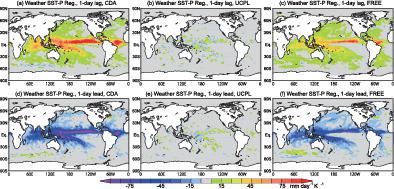当前位置:
X-MOL 学术
›
Q. J. R. Meteorol. Soc.
›
论文详情
Our official English website, www.x-mol.net, welcomes your
feedback! (Note: you will need to create a separate account there.)
Improvements in tropical precipitation and sea surface air temperature fields in a coupled atmosphere–ocean data assimilation system
Quarterly Journal of the Royal Meteorological Society ( IF 3.0 ) Pub Date : 2021-01-07 , DOI: 10.1002/qj.3973 Yosuke Fujii 1, 2 , Toshiyuki Ishibashi 1 , Tamaki Yasuda 3 , Yuhei Takaya 1 , Chiaki Kobayashi 1 , Ichiro Ishikawa 1
Quarterly Journal of the Royal Meteorological Society ( IF 3.0 ) Pub Date : 2021-01-07 , DOI: 10.1002/qj.3973 Yosuke Fujii 1, 2 , Toshiyuki Ishibashi 1 , Tamaki Yasuda 3 , Yuhei Takaya 1 , Chiaki Kobayashi 1 , Ichiro Ishikawa 1
Affiliation

|
A coupled atmosphere–ocean data assimilation system, the Meteorological Research Institute‐Coupled Data Assimilation System Version 1 (MRI‐CDA1), was developed based on the coupled atmosphere–ocean general circulation model and separate atmosphere and ocean analysis routines operated by the Japan Meteorological Agency (JMA). To implement coupled atmosphere–ocean data assimilation, 6‐hr data assimilation cycles with the coupled model in the outer loop are adopted in atmospheric data assimilation, whereas incremental analysis updates with 10‐day data assimilation cycles are adopted in ocean data assimilation. A coupled data assimilation (reanalysis) experiment (CDA‐Exp) is conducted using MRI‐CDA1 along with an uncoupled reanalysis experiment (UCPL‐Exp) in which the same atmospheric component of the coupled model is forced by prescribed sea surface temperature (SST) similarly to the JMA reanalysis, JRA‐55. Climatological precipitation and variations in precipitation and sea surface air temperature (SAT) are better represented in CDA‐Exp than in JRA‐55, which is brought about by the modification of the atmosphere model physics of the coupled model to better represent climate states. In CDA‐Exp, the SST adjustment to the atmosphere amplifies the lead/lag correlations between subseasonal variations of SST and precipitation. The atmosphere–ocean coupling generates SST variations associated with tropical instability waves, and the SAT field responds to SST variations. The SST–precipitation and SST–SAT relationships on the weather timescale are also recovered in CDA‐Exp, although they are hardly seen in UCPL‐Exp. The coupled model physics generates weather‐timescale SST variations consistent with the atmospheric state, and the atmospheric parameters respond to the SST variations through the coupled model physics. This study suggests that the benefits of coupled data assimilation would be more evident if the ability of MRI‐CDA1 to represent SST variations and its interaction with the atmosphere are improved.
中文翻译:

大气-海洋数据同化系统耦合下热带降水和海面气温场的改善
基于日本海洋气象局运行的大气-海洋耦合环流模型以及单独的大气和海洋分析程序,开发了一种大气-海洋耦合数据吸收系统,即气象研究所-耦合数据吸收系统版本1(MRI-CDA1)。代理商(JMA)。为了实现大气-海洋耦合数据同化,大气数据同化采用外环耦合模型的6小时数据同化周期,而海洋数据同化采用10天数据同化周期的增量分析更新。使用MRI-CDA1进行了耦合数据同化(重新分析)实验(CDA-Exp)以及未耦合的重新分析实验(UCPL-Exp),其中规定的海面温度(SST)迫使耦合模型的相同大气成分类似于JMA重新分析JRA‐55。CDA-Exp中的气候降水以及降水和海面气温(SAT)的变化要比JRA-55更好,这是由于对耦合模型的大气模型物理进行了修改以更好地表示气候状态所致。在CDA-Exp中,对大气的SST调整会放大SST的亚季节变化与降水之间的超前/滞后相关性。大气-海洋耦合产生与热带不稳定波有关的海表温度变化,SAT字段会响应SST的变化。尽管在UCPL-Exp中几乎看不到,但是在CDA-Exp中也恢复了天气时标上的SST-降水和SST-SAT关系。耦合模型物理学产生与大气状态一致的天气时标SST变化,并且大气参数通过耦合模型物理学响应SST变化。这项研究表明,如果改善MRI-CDA1代表SST变化及其与大气相互作用的能力,则耦合数据同化的好处将更加明显。耦合模型物理学生成与大气状态一致的天气时标SST变化,并且大气参数通过耦合模型物理学响应SST变化。这项研究表明,如果改善MRI-CDA1代表SST变化及其与大气相互作用的能力,则耦合数据同化的好处将更加明显。耦合模型物理学产生与大气状态一致的天气时标SST变化,并且大气参数通过耦合模型物理学响应SST变化。这项研究表明,如果改善MRI-CDA1代表SST变化及其与大气相互作用的能力,则耦合数据同化的好处将更加明显。
更新日期:2021-03-07
中文翻译:

大气-海洋数据同化系统耦合下热带降水和海面气温场的改善
基于日本海洋气象局运行的大气-海洋耦合环流模型以及单独的大气和海洋分析程序,开发了一种大气-海洋耦合数据吸收系统,即气象研究所-耦合数据吸收系统版本1(MRI-CDA1)。代理商(JMA)。为了实现大气-海洋耦合数据同化,大气数据同化采用外环耦合模型的6小时数据同化周期,而海洋数据同化采用10天数据同化周期的增量分析更新。使用MRI-CDA1进行了耦合数据同化(重新分析)实验(CDA-Exp)以及未耦合的重新分析实验(UCPL-Exp),其中规定的海面温度(SST)迫使耦合模型的相同大气成分类似于JMA重新分析JRA‐55。CDA-Exp中的气候降水以及降水和海面气温(SAT)的变化要比JRA-55更好,这是由于对耦合模型的大气模型物理进行了修改以更好地表示气候状态所致。在CDA-Exp中,对大气的SST调整会放大SST的亚季节变化与降水之间的超前/滞后相关性。大气-海洋耦合产生与热带不稳定波有关的海表温度变化,SAT字段会响应SST的变化。尽管在UCPL-Exp中几乎看不到,但是在CDA-Exp中也恢复了天气时标上的SST-降水和SST-SAT关系。耦合模型物理学产生与大气状态一致的天气时标SST变化,并且大气参数通过耦合模型物理学响应SST变化。这项研究表明,如果改善MRI-CDA1代表SST变化及其与大气相互作用的能力,则耦合数据同化的好处将更加明显。耦合模型物理学生成与大气状态一致的天气时标SST变化,并且大气参数通过耦合模型物理学响应SST变化。这项研究表明,如果改善MRI-CDA1代表SST变化及其与大气相互作用的能力,则耦合数据同化的好处将更加明显。耦合模型物理学产生与大气状态一致的天气时标SST变化,并且大气参数通过耦合模型物理学响应SST变化。这项研究表明,如果改善MRI-CDA1代表SST变化及其与大气相互作用的能力,则耦合数据同化的好处将更加明显。











































 京公网安备 11010802027423号
京公网安备 11010802027423号